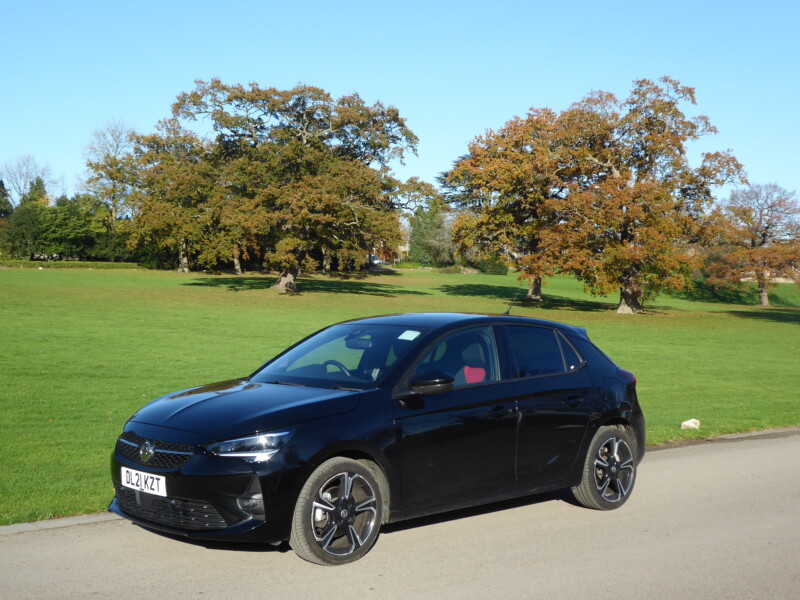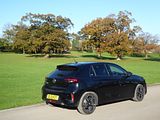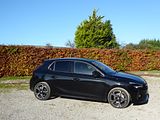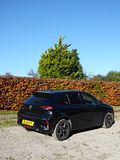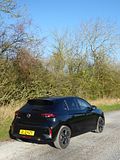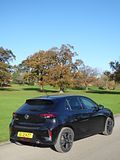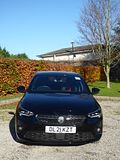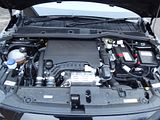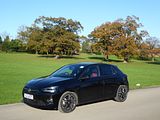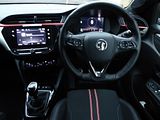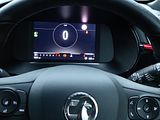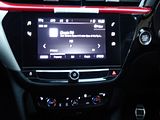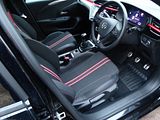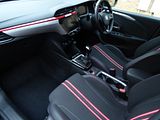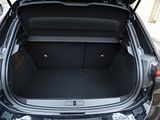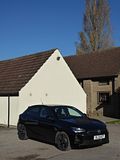The Corsa is an important car for its maker, Opel/Vauxhall, selling in large quantities right across Europe. Indeed in the UK, in recent times, it has managed to outsell Ford’s Fiesta on several occasions and has even claimed the Number One monthly sales spot more than once. The fifth generation Corsa, launched in 2014 was – despite what was said at the time of its debut – a heavy facelift of a car that was first seen in 2006, and whilst that update had addressed some of the weaknesses of the Corsa D (fourth generation), it was clear that further improvements would require a complete rethink. Indeed a new model was well advanced in its development when in 2017 parent company GM decided to sell the European business to PSA. Rather than proceed with the final stages of development, the new owners took the bold decision to scrap what they had inherited and to start again with a completely different car, using the same CMP platform as underpinned their own small cars, the Peugeot 208 and Citroen C3, leveraging the economies of scale that would result. They worked in record time and the new PSA-based car made its debut in the autumn of 2019. Sales started early in 2020 just as the world went into lockdown, thus giving the sixth generation Corsa a second difficult challenge even before the third hit, as the global chip supply crisis kicked in. Nonetheless, sales did get underway during 2020 and have built up steadily, so the Corsa F is now a reasonably common sight on our roads. The Corsa has also long been a common sight in the rental car facilities, and during 2021, this new sixth generation car has started to appear in quantity as its predecessor is phased out of the fleets. Indeed, it would seem to be about the only new car that rental car giants like Hertz have bought in 2021 and with the pruning of their fleets to match the recovering-from-Covid levels of demand, it is about the only car they seem to have on fleet. So when I booked a rental of a small car for a few days in the autumn of 2021, it was indeed a Corsa that I got. I did not even get a choice of colour, this one coming in photographically challenging black, with black wheels. Having been pleasantly surprised when I finally drove a Corsa E only twelve months earlier, that it was better than I expected, and having seen that the press thought this one was a significant improvement in most respects, my expectations were quite high for this car. Did it live up to its promise? Read on!
One of the consequences of the shift to a PSA platform is that the Corsa now uses PSA engines. At launch, Corsa F came with a choice of petrol and diesel engines with the promise that a full electric version would follow a few months later. It was expected that this would capture a significant percentage of Corsa sales, and that the rest would mostly be of the petrol powered cars. All the petrol cars use the same 1.2 litre 3 cylinder engine which is offered in two form of a tune, 75 PS or 100PS. The less powerful car has a five speed gearbox, whilst the 100PS car has a 6 speed manual or the option of an 8 speed EAT8 automatic. Most buyers select the 100PS unit and indeed that is the one that was in the test car. I’ve not yet sampled any of the PSA cars with this engine, but based on what I had read, I was expecting this to be an impressive unit. And so it proved to be. The Corsa is still a relatively small car, so 100PS should be enough to endow what is still quite a small car with decent performance and that is exactly what I found. The engine is smooth and refined and the noise it generates is quite muted, so although you can detect that this is a 3 cylinder, many people probably won’t notice. They’ll be the ones who don’t care, which is going to be the majority of people who buy a Corsa, I suspect. Initially the engine might not feel that impressive, but as you get underway, and once the turbo gets busy you will find that this engine will pull and pull and so the Corsa proves to be quite lively, making full use of the 151 lb/ft of torque that is available from just 1750 rpm. Ultimately, of course, it’s not that fast, but it does feel like there might be more than 100 horses available. To get the best out of the car you will need to use the gears a lot, as the upper gear ratios are high, which means limited acceleration, but in second and third, the car pulls strongly. The gearchange is good, with the lever slotting cleanly into the next ratio, with the exception of reverse, which proved quite difficult to engage even when the release collar was pressed hard, but the gear knob was far too big so holding the gear lever was not that pleasant. Once up to speed, the Corsa could cruise quietly on the motorway, with not just the engine note, but also the wind and tyre noise sources well suppressed. There is no penalty for the zesty engine at the fuel pump. Official figures suggest that the 100PS car is more economical than the less potent car (though the 1.5 diesel will do better still). I averaged around 50 mpg in the week I had the Corsa, during which time I did a mix of motorway and urban motoring. The Corsa features a Stop/Start system, which works unobtrusively. Disappointingly, the car proved much harder to turn off intentionally. I found I had to press the Stop Engine button an average of three or four times to get the engine off.
Once upon a time, the SRi badge denoted a sporty version of a Vauxhall that was sharper to drive than lesser models. Not any more. There is nothing remotely sporting about the way this Corsa steers and handles. The steering is very light and vague, having no discernible feel at all. It’s not the first Vauxhall where I’ve experienced this, but they are not all so blighted so I have to assume that this is deliberate and that this is indeed what it is believed that many customers actually want. So, driving enthusiasts, look away now. The handling is actually not bad, and there is plenty of grip, so provided you can work out what the wheels are doing, you can drive this car with a bit of spirit, but you won’t really get any pleasure from so doing. This Corsa came on 205/45R17 alloys and the ride – apparently specially tuned to cope with British roads – was on the harsh side. Like so many cars these days, it was not bad on very smooth roads but there are very few of those, and on more typical surfaces it could get caught out by bumps and lumps and it was generally a bit too rough and jarring for comfort. The brakes, at least were good and the electronic handbrake disengages cleanly. Sadly, visibility is not brilliant, either. There are thick B and C pillars so the view over your shoulder is not great and the rear window is fairly small, so you don’t get a great view behind you either, though the rear parking sensors were a real help when parking up in tight spaces. The Corsa comes with many of the latest safety features. I was pleased to find that although it does have Lane Keep Assist, this is easy to turn off. And turning it off is exactly what you will want to do, as it was as annoying here as almost all these systems are.
The previous generation Corsa’s interior was a marked improvement on what had gone before. Unfortunately, in a misguided attempt to be trendy, this Corsa seems to have gone backwards in many ways. The first word I wrote down in my test notes was “horrid”. There are a lot of cheap and nasty plastics – not just lashings of fashionable gloss black, which is a magnet for dust and fingerprints in equal measure – but also plenty of grey and red inserts, presumably in an attempt to be trendy and to add some colour to an otherwise black interior. Whilst the top of the dash looks and feels OK, the rest of the plastics used lower down are cheap and nasty, hard and scratchy. The Corsa’s maker would have been well advised to have spend their money on some better quality here rather than the gimmicky configurable instrument cluster, which solves a non-existent problem with a complex solution that few people probably really care about. You can cycle through various options from buttons on the left hand spoke of the steering wheel, but it is very easy to end up with a cluster that looks almost empty and there no getting away from the fact that the fuel gauge and water temperature, both in dot chart form, are very small. At least there is the saving grace of a leather wrapped wheel that was quite agreeable to hold. The boss of this also contains audio repeaters and cruise control buttons. There are two chunky column stalks, including an auto function for the wipers. There is a rotary on the dash for the lights which also have an auto function. The centre of the dash contains the touch screen. In this version, the 7” screen is not used for much more than the radio, and you will have to use the screen as the only knob that remains is for audio volume. The unit does include a DAB radio. Vauxhall will sell you versions of the Corsa with navigation integrated into the touch screen, but if it not there (as indeed it was not on the test car), then you can get navigation by pairing from your phone. I have to say that the screen itself was not that appealing to look at. Beneath it are the controls for dual zone climate control which comes as standard.
Sadly, my disappointment from the interior was further compounded by a truly uncomfortable driving position. The problem is not the seats. The SRI gets what are called sports seats, which is probably stretching a point a little, but they proved quite comfortable, and come with plenty of available adjustment – manual of course – with a turn wheel on the side of the seat for the backrest and in the case of the driver only, a height adjuster. They were even covered in a pleasant sort of cloth material and, as part of the Premium package, they have a heating element for those cold morning starts. Add in a telescoping wheel, also heated with the Premium package, and all should have been good. But it is not, as it all goes badly wrong with the pedals. For a start, they are very small, but the real problem is that they are also very offset. There is a big height difference between the brake and accelerator pedal, which you can probably sort of live with, but the clutch was the real culprit. There was a lot of travel, the bite point was so high that I could not leave the heel of my foot on the floor as I released it, and there is no space around it for your foot when you are not using it. Combined that made this one of the most awkward driving positions I have come across in a long time. Even if there were nothing else wrong with the Corsa – and sadly there is plenty else to dislike – this would be a complete deal breaker for me.
The previous generation Corsa was one of the roomiest cars for rear seat passengers. Sadly that is not the case now, with this version of the Corsa having noticeably less space than its predecessor or indeed any of its rivals, even though it is longer and wider than many of them. There is just about enough width for two large adults here, but, thanks to the fact that this Corsa is a full 44mm less tall than its predecessor, headroom is surprisingly limited, whilst legroom will obviously depend on how far forward the front seats are. Even if the seats are well forward, you would not describe the space here as good. Push the seats well back and this becomes a rear compartment for kids only. Oddments provision is limited, too, with two very small door pockets being all you get.
Thankfully, space is less limited, by class standards, in the boot. There is a lip over which you must lift luggage, but the space itself is quite deep, and it is a nice regular shape with no suspension intrusion. As there is no standard spare wheel (you can buy one as a cost option), there is room under the floor for a few more odds and ends. Unlike the rear seats, the boot is actually among the biggest in the class. The asymmetrically split rear seat backrests fold down, but the resulting load bay is far from flat, so it will certainly allow you to get longer items in but the space would be more useful of the floor was flat. Inside the cabin there is an awkward glovebox with split level access, some small door pockets, a very modest cubby under the central armrest and a recess in front of the gearlever. Just about enough for most people, but again not generous.
Unlike the complex range of its predecessor, Vauxhall has simplified the Corsa F trim line-up considerably. It starts with the SE which has 16-inch alloy wheels, LED headlights, electric front windows, and air conditioning. You also get a 7-inch infotainment screen, DAB radio, Bluetooth connection, and Apple CarPlay and Android Auto with no subscription fee. Move to the Vauxhall Corsa in SRi trim and you gain different alloys, LED front fog lights, electric rear windows, and a sporty styling pack for the outside including rear privacy glass, black roof and chrome-topped exhaust. It also has rear parking sensors and a roof spoiler. Inside, the Corsa SRi has sports front seats and alloy foot pedals. With the Vauxhall Corsa Elite Nav, you have the 10-inch infotainment screen with 2- and 3D navigation mapping, Vauxhall Connect live traffic updates, and electric folding door mirrors. There’s also leather-effect upholstery, rear parking camera and blind spot alert, front parking sensors, heated front seats and steering wheel, and automatic wipers and lights. The Vauxhall Corsa Ultimate Nav has 17-inch alloy wheels, leather seat trim with massage function for the driver, keyless entry and ignition, and IntelliLux headlights. It also come with climate control and adaptive cruise control. Vauxhall also offers Nav and Premium options for the SE and SRi. The Nav brings, funnily enough, integrated sat-nav, while the Premium versions provide automatic headlights, and heated front seats and steering wheel.
I had high hopes for this Corsa, not least because the car had received quite favourable reviews when it was launched. To say I was disappointed is something of an understatement. There was so much about this car that I thought was unimpressive, such as the nasty quality interior and the cramped rear seats, as well as the rather insipid driving experience and stiff ride that I would already be placing this car near the bottom of the class, but add in the truly terrible driving position and this car earns the rare un-accolade of “actively avoid” from me. Indeed, when Hertz tried to give me another one, I expressed the fact that I simply could not face another one again, and would (and did!) take a downgrade to avoid it. They did not seem completely surprised, so I guess I might not be the only person to have expressed such disappointment. Given the number of them that you see on the roads, though, clearly a lot of Corsa owners either don’t care or just put up with its many failings. They really could do a lot better with just about anything else on the market.

